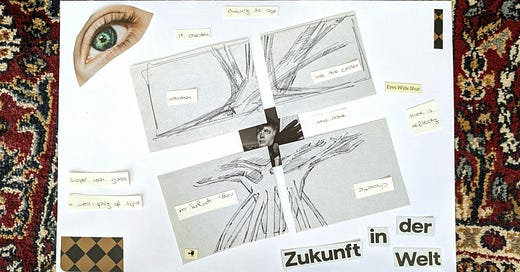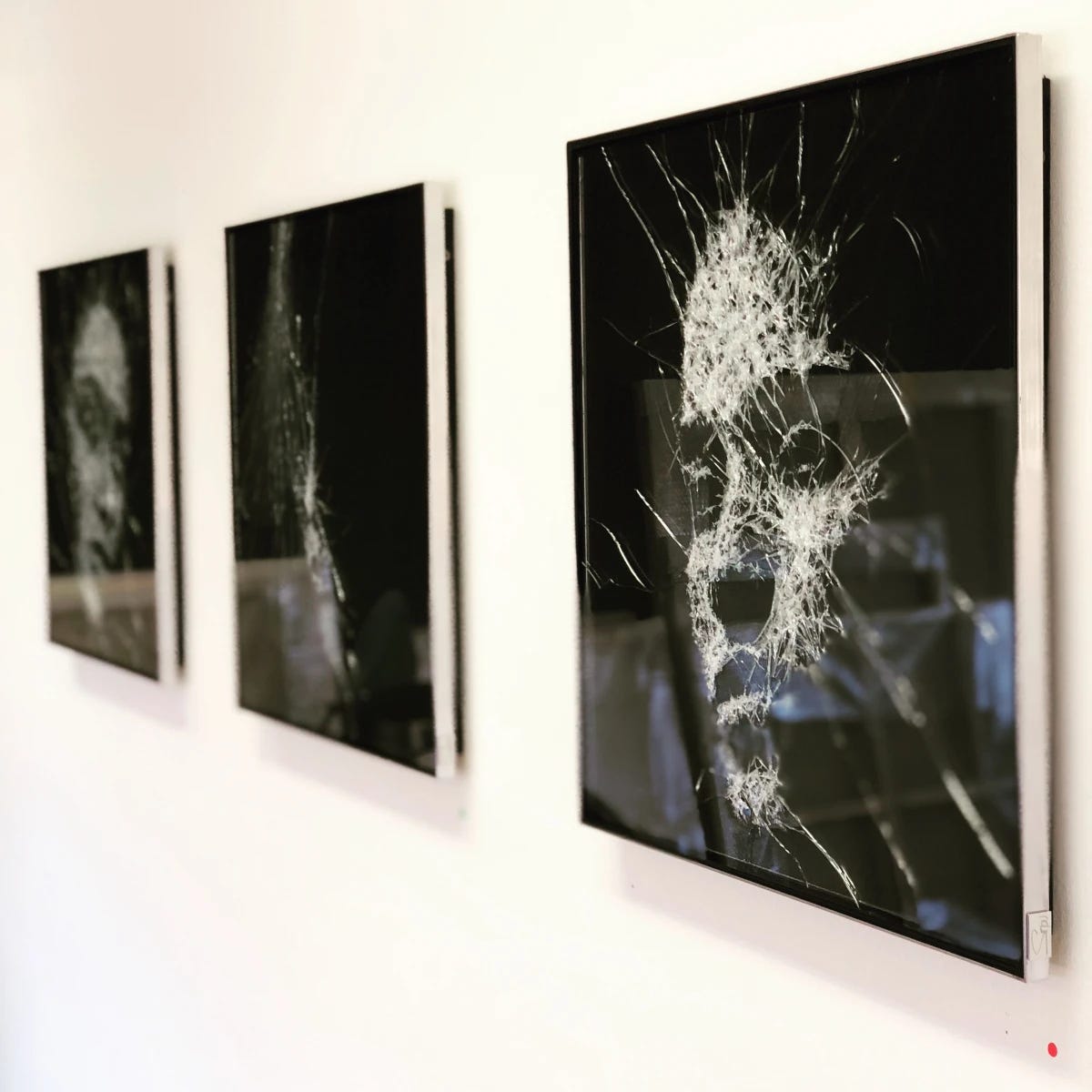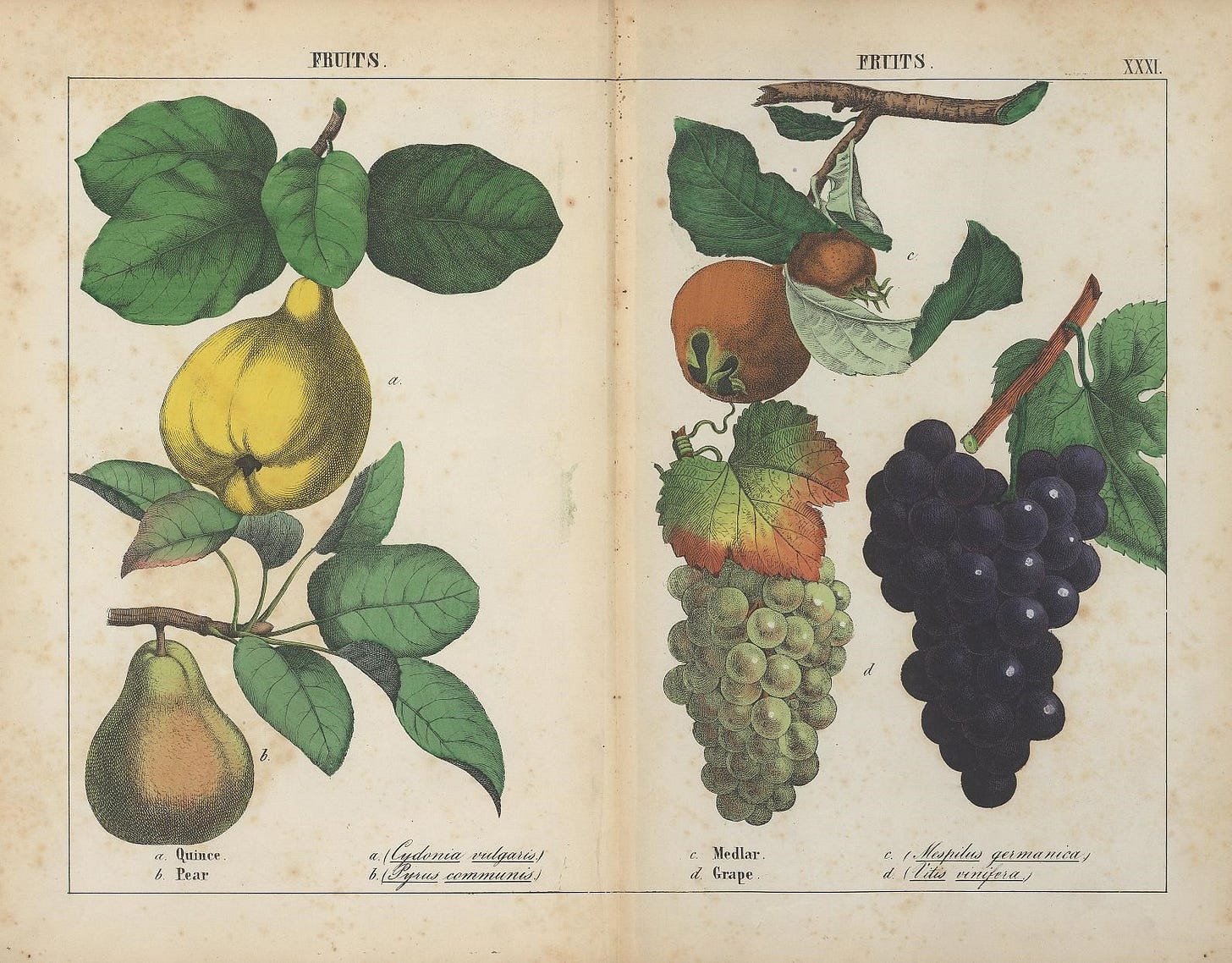The moment my scissors touched the paper, I felt like I was doing something naughty. A neighbour of mine had given me a pile of posters of trees, originally drawn by his father Stefan Wewerka, a well-known German architect and designer. I took a poster out of the pile to make a collage and thought about the cut-up technique, as well as the connections between creation, destruction, renewal, and transformation.
What is the cut-up technique?
The cut-up technique was popularised by William S. Burroughs, one of the most famous members of the Beat Generation. It came out of the work of Brion Gysin and his poem “Minutes to Go”, and was soon followed by a collection of other writers. The cut-up technique is:
“a mechanical method of juxtaposition in which Burroughs literally cuts up passages of prose by himself and other writers and then pastes them back together at random.”
The idea of cutting up one thing to make another, re-connecting pieces to see what is hidden beneath the surface, is an interesting one. But actually doing it feels strange - have you ever tried to cut up a book?
Burroughs noted the same:
“There's been a lot of that, a sort of superstitious reverence for the word. My God, they say, you can't cut up these words. Why can't I?”
There is a resistance to destroying certain things but not others: do we hesitate when we slice through an apple, or when we disturb the evenness of the soil to plant a seed? The apple can never be put back together, and the soil is irrevocably changed, but we rarely think about it. Destruction of the old is a part of everything new.
Some artists lean into this, such as Simon Berger, a contemporary glass artist who creates portraits through smashing glass panels. In his work he highlights the role of destruction in creation, rather than letting the destructive root of art remain hidden in the background. It is not very often that we look at a painting and consider the death of the empty canvas.
Burroughs explains that all writing and all creative production is in part destructive and selective, incorporating loss at every turn. Each step is a process of choosing one idea, one word, one brush stroke, while letting another fall by the wayside and die a creative death.
What is any writing but a cut-up? ... Remember that I first made selections. Out of hundreds of possible sentences that I might have used, I chose one.
The un-chosen sentences and the un-chosen brush-strokes are not destroyed per se, but they are not created either, banished to a meandering liminal space of ideas that could be used later, or perhaps not. More directly, all writing, all painting, all ideas destroy the “emptiness” that came before: the lack of existence of that thing, those words, that image, that conversation. The Chilean poet Nicanor Parra explains it in his poem Young Poets:
Write as you will
In whatever style you like
Too much blood has run under the bridge
To go on believing
That only one road is right.
In poetry everything is permitted.
With only this condition of course,
You have to improve the blank page.
Whether this goal is achieved or not is a matter of interpretation, but all writing destroys the beauty and the potential of the blank page simply by being brought into existence. Every meandering thought intrudes upon and transforms the stillness and silence of the meditating mind, and all meditative states override the continual narrative of the Self. The beginning of each second (and split-second thereof) necessitates the ending of the previous one.
Destruction and creation
Heraclitus, the ancient Greek philosopher, held a worldview that everything in the cosmos was constantly in flux, including cycles of creation and destruction.
“This world-order [kosmos], the same of all, no god nor man did create, but it ever was and is and will be: everliving fire, kindling in measures and being quenched in measures.”
Our human relationships with destruction, death, transformation and renewal are complicated. In the form of war, materialism, over-consumption and other forms of evil, it seems that humans are okay with certain forms of destruction: being in control of the destruction can even be satisfying. And yet, the closer destruction comes, or the more it is out of our control, the more we panic.
But death, destruction and transformation are all around us in the form of the seasons, the decay of living things, and the requirement that we wake to a new day instead of being able to remain in the one before it. Movement and transformation always require a sacrifice of some kind. Destruction is not necessarily a bad thing. In a statement attributed to Chief Seattle, he explains:
There is no death, only a change of worlds
In the cut-up technique and the process of creativity, as well as the movements of creation and destruction of life, all remind us of the transience of things. Cutting up a book may feel strange, but the book was previously a tree, the tree previously a seed, and the seed previously nestled deep within a nut or fruit, hanging somewhere in the sun.
Why do we hesitate and hold a particular kind of reverence for human products such as a picture or a novel, before cutting it up? Is there less beauty in the apple than in the book?
The cut-up technique and the destruction of one thing to create something new may carry with it numerous uncomfortable questions, leading to the root of beauty, nature, the cycles of life and our role in these processes. Nonetheless, we continually participate in and observe certain kinds of evolution and transformation, all of which require the loss of the thing that came before it. Many of these processes are out of our control. When considering the ones that are our choice, we must always ask ourselves what we are gaining through the destruction of one thing, in the hope of creating another.
In my case, making artwork out of an old print of a tree provided two things: first, a collage that brought me joy; and second, an increased appreciation of the process of transformation, and the opening of a door to larger questions. Whether or not these things were worth it (improving the blank page, so to speak), is up for interpretation.
Weekly Musings:
Book recommendation: The Light Pirate, by Lily Brooks-Dalton. A story of adaptation in a world in which the impacts of climate change have transformed daily life for most Americans. Wanda, a girl born during one of the most severe of the increasingly-common hurricanes, begins to form a new community and a new way of life in the midst of the ruins of Florida.
Music recommendation: "Outta My Head" by Jeon Somi. We love K-pop in this house.
Artist recommendation: Dave Ball: http://www.daveballartist.co.uk/selected.html Most of his work revolves around absurd art. His work includes performing 225 different activities with each biscuit from a packet of biscuits, walking through the Welsh landscape without looking at it, interviewing a houseplant, and producing a museum of uninteresting things.






